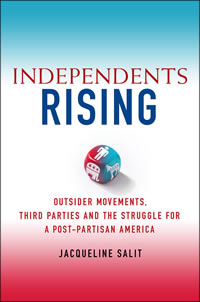Independents Rising: Outsider Movements, Third Parties, and the Struggle for a Post-Partisan America
Jacqueline S. Salit. Palgrave Macmillan, $25 (256p) ISBN 978-0-230-33912-5
Given the upcoming presidential election, Salit’s earnest and informative book is sure to be consulted by those trying to understand the enigmatic and influential independent voter. Independents first spilled into the mainstream with the 1992 presidential campaign of Ross Perot (who garnered 19% of the popular vote) and have been a driving source of politics ever since. Salit, president of IndependentVoting.org and publisher of The Neo-Independent magazine, details the history of independents from Perot to Bloomberg and into the age of Obama. Covering both national and regional concerns, the book is strongest when it demystifies the movement itself. As Salit emphatically illustrates, independents are not motivated by ideology but, rather, by a desire to reform the current political system. Such reforms would include opening up primary elections and the end of partisan dominance. Salit often touts her credentials within the movement, but her closeness to the story serves to highlight the book’s weaknesses, which include the sometimes defensive tone, bland anecdotes about lunch meetings, and confusing accounts of political infighting. Regardless, the book gives necessary voice to voters who are fed up with partisan politics and desire change. Agent: Robert Guinsler, Sterling Lord Literistic. (Aug.) Reviewed on: 04/30/2012
Other Formats
Open Ebook – 256 pages – 978-1-137-07255-9
The independent movement began to grow in the 1970s when Fred Newman launched the New Alliance Party in an attempt to beat back the bipartisan election process. The party gained acceptance among minorities and progressive whites, groups who felt they had been shut out of the system. In 1988, Lenora Fulani, the party’s presidential candidate, was slated on the ballot of all 50 states—not only the first woman, but also the first African-American to do so.
As the NAP expanded, their influence was felt in both local and national politics. Eventually, Fulani and Newman joined Nicholas Sabatine to form the Patriot Party, which was absorbed in California by the Reform Party. As the quest expanded across the country, the candidacy of Ross Perot really put the independent movement on the map. Salit managed Michael Bloomberg’s mayoral race for the Independence Party, proving that they could be a great influence in politics. Two other significant instances in which independent voters displayed their power were the 2008 presidential election and the 2010 congressional elections. As she explains the pitfalls of political life, the author demonstrates her expertise in the fight to give nonpartisan voters a more potent voice in the democratic process.
Fighting against the strong political machines of a two-party system may seem Sisyphean now, but Salit’s story of how well they’ve done so far inspires hope that one day they will succeed. Review Issue Date: May 15, 2012 Online Publish Date: May 2, 2012
EXAMINER.com
BY: KEN BINGENHEIMER – April 25, 2012
Partisan gridlock has pushed public approval of Congress’s performance into single-digit territory, and the single largest–and growing–political group in the country is the non-affiliated voters. Yet in much of the country, this massive group is disenfranchised, denied the ability to exert any influence in primary elections and forced to choose between increasingly partisan party nominees in the general election.
George Washington’s views on political parties are powerfully relevant today. He said, in his Farewell Address, that political parties can “become potent engines by which cunning, ambitious, and unprincipled men will be enabled to subvert the power of the people, and to usurp for themselves the reins of government.”
Washington’s fears have been realized, and that fact has spawned the Tea Party and Occupy movements and the proliferation of non-affiliated voters. The American people want that power back.
In her book, Independents Rising, Jacqueline Salit chronicles the growth and maturation of the independent movement over the last quarter century, and exposes the fallacy of viewing independents as just Democrats or Republicans who don’t want to actually be party members, but who can nonetheless be counted on to vote for the party’s nominee.
Who are independents?
“Who are these independents? A profusion of polling, focus groups, and profiles are suddenly dedicated to answering that very question. This is where the literal reading comes in handy. As someone involved in organizing independents for 30 years, I would advise putting all of the ‘data’ to one side. Listen to the simplest, the most obvious statement independents are making. No interpretation, polling, or focus group is needed. They are Americans who don’t want to align with any political party.”
Salit also refutes the misconception that independents are primarily moderates or centrists. She quotes a Pew Research Center study that found that “independents are not moderates but, instead, span the spectrum and combine social and economic views in unorthodox ways.”
Says Salit, “they are a social engine for political reform that goes beyond parties, partisanship, and traditional ideology. In this respect, independents are, by their choice, radicals–nonideological radicals, but radicals just the same.”
Radicals, by definition, want to change the system. And as she discusses the history of the independent movement, Salit spotlights some of these unorthodox alignments. She tells of how the independent movement, seeking political reform, partnered with Ross Perot when he ran his Reform Party presidential campaigns. And of how then, despite the deep philosophical differences some felt on social issues, movement organizations backed Pat Buchanan’s bid in 2000.
“We instructed Buchanan that social issues (right or left) were not a part of the Reform Party platform and that any effort to introduce them would be a violation of what the party stood for. Buchanan said he had no problem with that.”
Buchanan was also warned that, “if you attempt to turn this party into a right-wing party, we will destroy your campaign.” He did and they did.
Not third-party, anti-party
It was after the 2000 election that the independent movement moved away from the idea of creating a third party to become anti-party. Salit, who managed Michael Bloomberg’s three New York mayoral campaigns, describes the efforts to break the city out of its partisan model with party primaries and nominees, to become a non-partisan, open election as is the predominant system in most of the country’s major cities.
The effort met powerful opposition from all the political parties, large and small, because, “control of nominations is the bread and butter of party life.” Bloomberg supported the move, saying, “What the electoral process should be about is letting everybody have an equal say. . . . You’ve got to get rid of the partisan politics and party bosses who really limit the public’s choice.”
Also included is California’s successful move to a Top Two system where everyone gets to vote and the top two vote-getters in the non-partisan primary go to a run-off in the general election, even if they are both of the same party. Then-Gov. Arnold Schwarzenegger is quoted after that success saying, “The voters made a clear and decisive statement that the way to fix broken government is to expand democracy, contain the control exercised by political parties, and give greater power to the people.”
Salit touches on the efforts of groups such as No Labels and Americans Elect, but characterizes their objectives are being more aimed at making the system work again, whereas she argues that the political party system has out-lived its usefulness and needs to be replaced by a post-partisan system that allows full participation of all citizens at all levels.
“Restoring a ‘center’ rests on the supposition that the existing institutions and power relations can and should be restored. Independents, in contrast, are searching for ways to develop the political system in accord with changing times. . . . Independents, organized without being a third party, are battling for structural reforms that loosen the grip of parties on government and politics.”
Independents decide elections
Salit offers statistics to demonstrate that it was independents, in states where they are allowed to vote in primaries, who gave the major party nominations to Barack Obama and John McCain, and who then broke predominantly for Obama in the general election, seeking to install a post-partisan president.
When Obama failed or was unable to deliver that post-partisanship, it was then the independents who enabled the Republicans to take control of the House of Representatives in 2010. And independents are expected to cast the deciding votes this year as well.
Describing independents as a “becoming-organized force for a genuinely postpartisan politicial system,” Salit argues that, “the political power of independents rests in being outsiders, in not being attached to any party, major or minor. This movement-in-the-making changes the political environment by changing the rules of the game.”
But that power to decide elections has not yet been translated into representation.
“Some might say that independents, the 40 percent of voters not fully integrated into the political system, are simply the next group of Americans to be unfairly excluded. In other words, the demand for equality for independents should be seen as a classic civil rights issue.”
With more and more voters abandoning the political parties, decades of political organizing by independents may well be bringing us to the cusp of a new era in politics. But it won’t be quick or easy, as the parties rightly see this struggle as one that is, for them, a matter of life and death. If the American people want their power back, it is up to them to take it. It surely won’t be given freely.


{ 0 comments… add one now }
You must log in to post a comment.